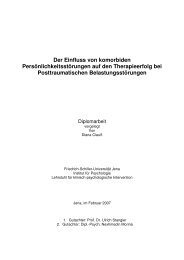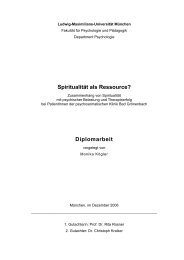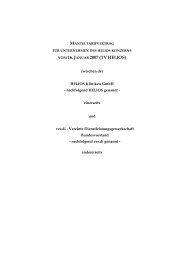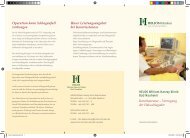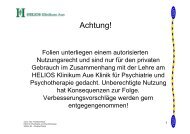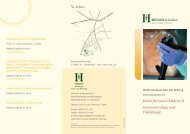Bindungstheorie, klinische Psychologie und Psychotherapie bei ...
Bindungstheorie, klinische Psychologie und Psychotherapie bei ...
Bindungstheorie, klinische Psychologie und Psychotherapie bei ...
Erfolgreiche ePaper selbst erstellen
Machen Sie aus Ihren PDF Publikationen ein blätterbares Flipbook mit unserer einzigartigen Google optimierten e-Paper Software.
1<br />
lungsstrategien. Stuttgart: Clett-Kotta.<br />
Kiesler, D.J. (1983). The 1982 interpersonal circle: A taxonomy for complementarity in<br />
human transactions. Psychological Review, 90, 185-214.<br />
Kirkpatrick, L.A. & Davis, K.E. (1994). Attachment style, gender, and relationship<br />
stability: A longitudinal analysis. Journal of Personality and Social Psychology,<br />
66 (3), 502-512.<br />
Kobak, R.R. (1989). The Attachment Interview Q-Set. Unpublished document, University of<br />
Delaware.<br />
Kobak, R.R., Cole, H.E., Ferenz-Gillies, R., Fleming, W.S. & Gamble, W. (1993). Attachment<br />
and emotion regulation during mother-teen problem solving: A control theory<br />
analysis. Child Development, 64, 321-345.<br />
Kobak, R.R. & Hazan, C. (1991). Attachment in marriage: Effects of security and accuracy<br />
of working models. Journal of Personality and Social Psychology, 60 (6), 861-869.<br />
Kobak, R.R. & Sceery, A. (1988). Attachment in late adolescence: Working models, affect<br />
regulation and representations of self and others. Child Development, 59, 135-146.<br />
Kobak, R.R., Sudler, N. & Gamble, W. (1992). Attachment and depressive symptoms during<br />
adolescence: A developmental pathway analysis. Development and Psychopathology, 3,<br />
461-474.<br />
Kobak, R.R. (1993). The attachment q-Sort. Unpublished manuscript.<br />
Köhler, L. (1992). Formen <strong>und</strong> Folgen früher Bindungserfahrungen. Forum der Psychoanalyse,<br />
8, 263-280.<br />
Leary, T. (1957). Interpersonal diagnosis of personality. New York. Ronald.<br />
Levy, M.B. & Davis, K.E. (1988). Lovestyles and attachment styles compared: Their<br />
relations to each other and to various relationship characteristics. Journal of<br />
Social and Personal Relationships, 5, 439-471.<br />
Lieberman, A.F. & Pawl, J.H. (1988). Clinical applications of attachment theory. In: J.<br />
Belsky & T. Nezworski (eds.), Clinical implications of attachment (pp. 327-351).<br />
Hillsdale, N.J.: Erlbaum.<br />
Links,P.S.(ed.).(1990).Family environment and borderline personality disorder.Washington:American<br />
Psychiatric Press.<br />
Liotti, G. (1991). Insecure attachment and agoraphobia. In Parkes, C.M., Stevenson-Hinde,<br />
J. & Marris, P. (Hrsg.) Attachment across the life cycle (pp. 216-233).<br />
Tavistock/Routledge, London and New York.<br />
Liotti, G. (1992). Patterns of attachment and the assessment of interpersonal schemata:<br />
Understanding and changing difficult patient-therapist relationships in cognitive<br />
psychotherapy. Journal of Cognitive Psychotherapy, 5, 105-114.<br />
Livesley, W.J., Schroeder, M.L. & Jackson, D.N. (1990). Dependent personality disorder<br />
and attachment problems. Journal of personality disorders, 4 (2), 131-140.<br />
Lohmer, M. (1988). Stationäre <strong>Psychotherapie</strong> <strong>bei</strong> Borderline Patienten. Berlin: Springer.<br />
Luborsky, L., Crits-Christoph, P., Alexander, L., Margolis, M. & Cohen, M. (1983). Two<br />
helping alliance methods for predicting outcomes of psychotherapy. Journal of<br />
Nervous and Mental Disease, 171, 480-491.<br />
Main, M. (1990). Cross-cultural studies of attachment organization: Rescent studies,<br />
changing methodologies, and the concept of conditional stategies. Human Development,<br />
33, 48-61.<br />
Main, M. & Goldwyn, R. (1985). Adult attachment classification and rating system.<br />
Unpublished manuscript, University of California, Berkeley.<br />
Main, M. & Goldwyn, R. (1992). Adult attachment scoring and classification systems.<br />
Unpublished manuscript, University of California, Berkeley.<br />
Main, M. & Hesse, E. (1990). Parents´ unresolved traumatic experiences are related to<br />
infant disorganized attachment status: Is frightened and/or frightening parental<br />
behavior the linking mechanism?. In Greenberg, M.T., Ciccetti, D. & Cummings, E.M.:<br />
Attachment in the preschool years (S. 161-182). Chikago: The university of Chikago<br />
Press.<br />
Main, M., Kaplan, N., & Cassidy, J. (1985). Security in infancy, childhood, and adulthood:<br />
A move to the level of representation. In Bretherton, I. & Waters, E. (Eds.),<br />
Growing points in attachment theory and research. Monographs of the Society for<br />
Research in Child Development, 50, 66-104.<br />
Main, M. & Solomon, J. (1986). Discovery of an insecure disorganized/disoriented attachment<br />
pattern. Procedures, findings and implications for the classification of<br />
behavior. In T.B. Brazelton & M. Yogman (Hrsg), Affective development in infancy.<br />
Norwood, NJ: Ablex.<br />
Mellsop, G., Varghese, F., Joshua, S. et al. (1982). The reliability of axis II of DSM-



